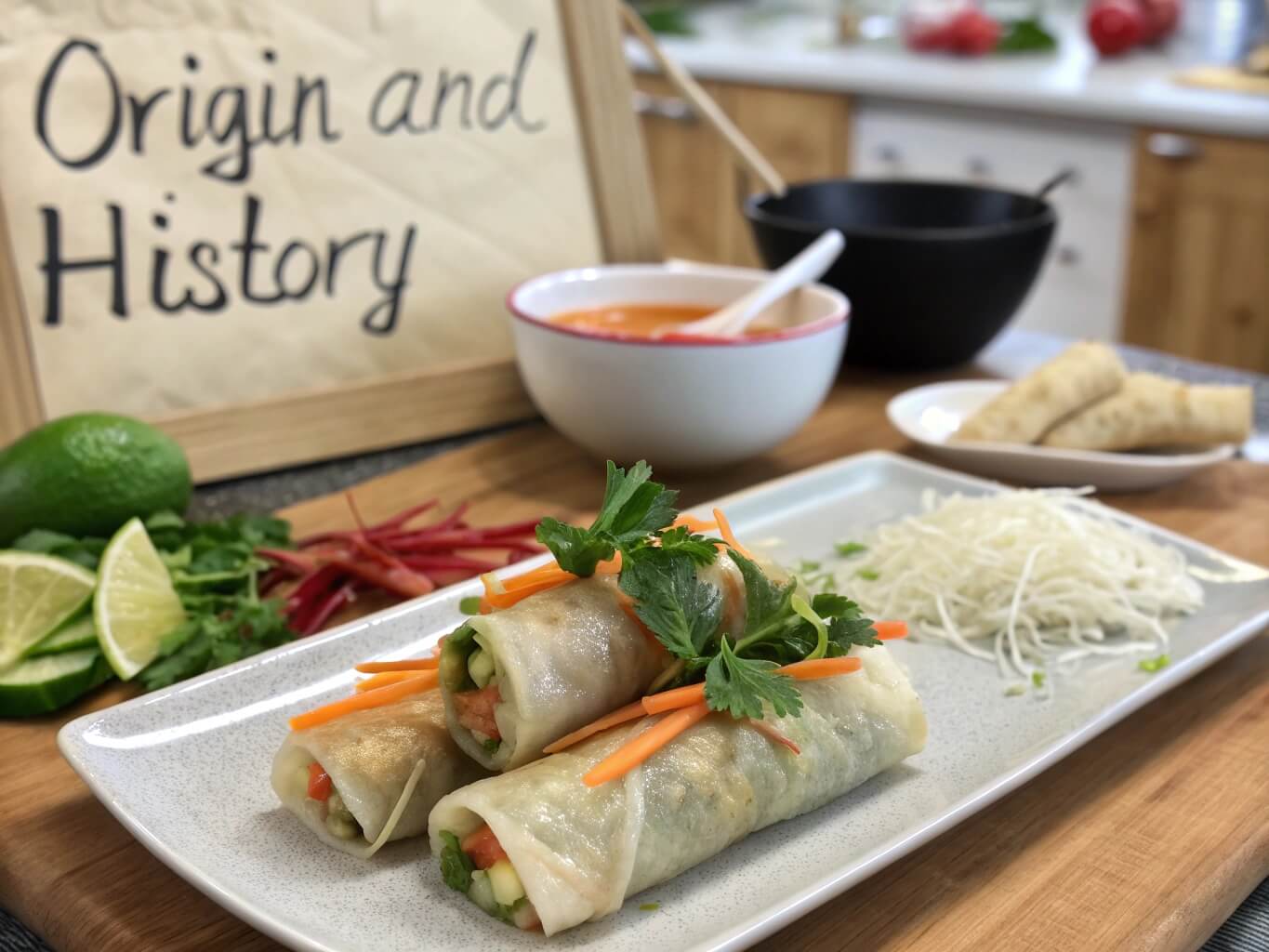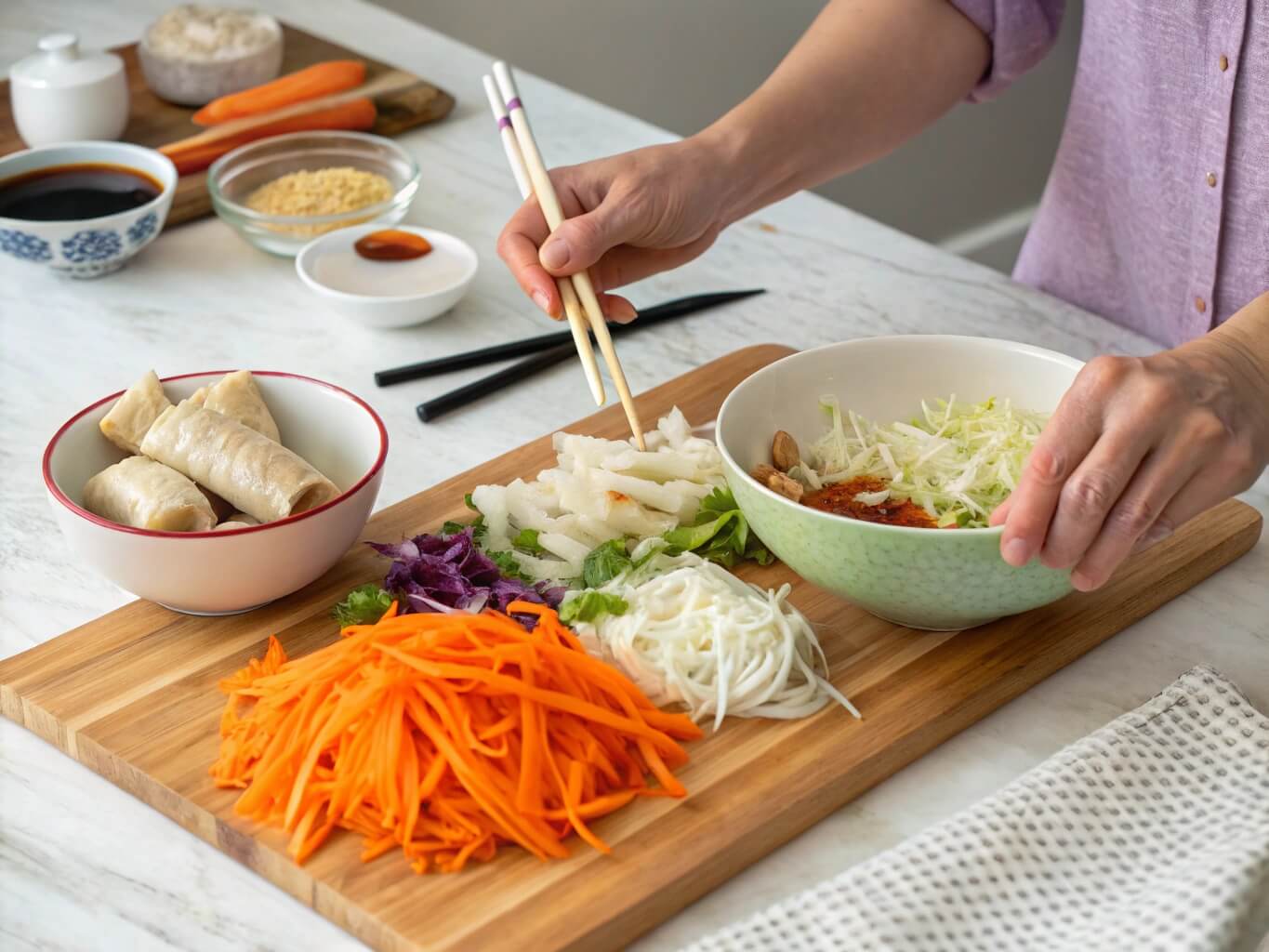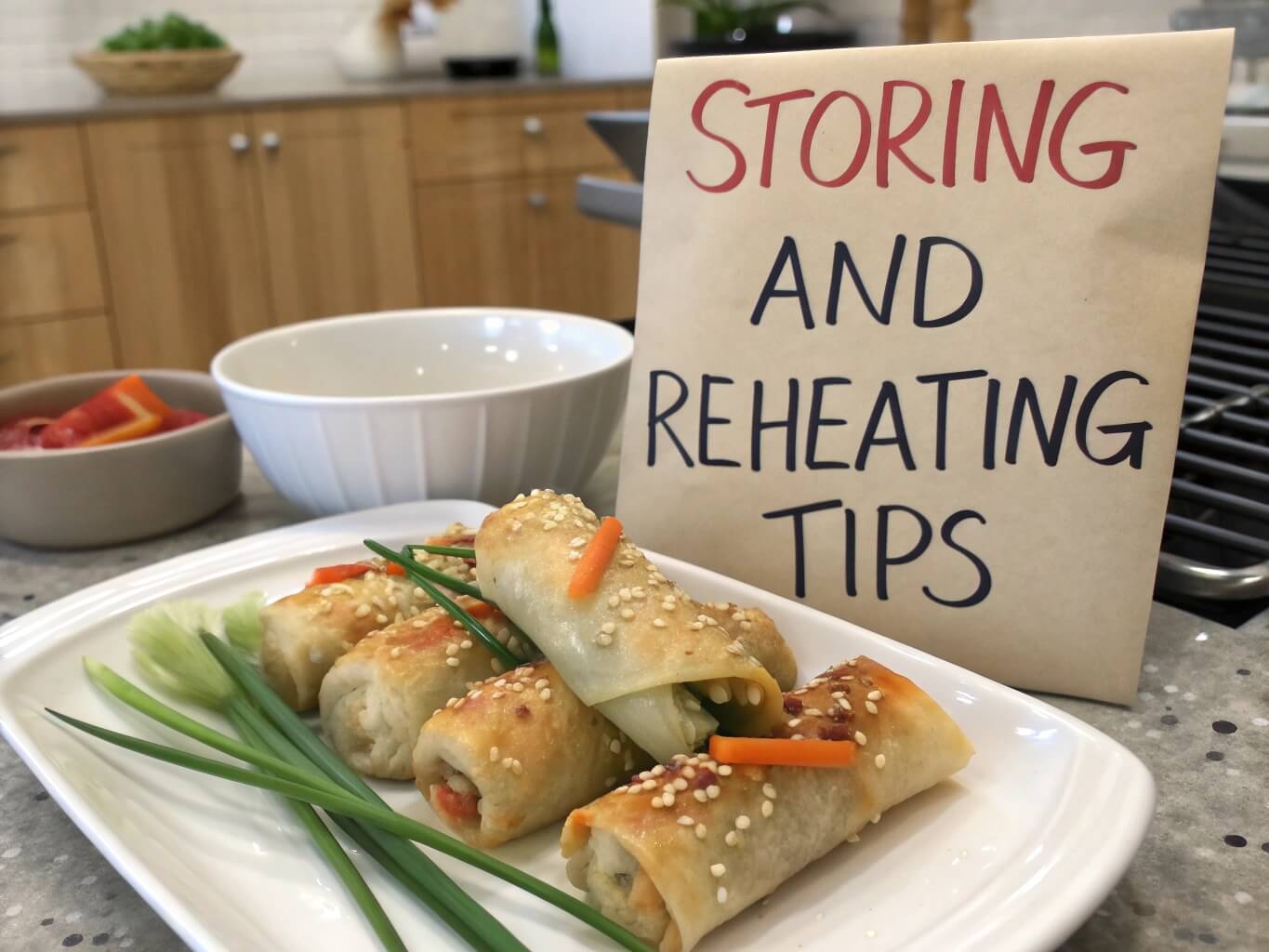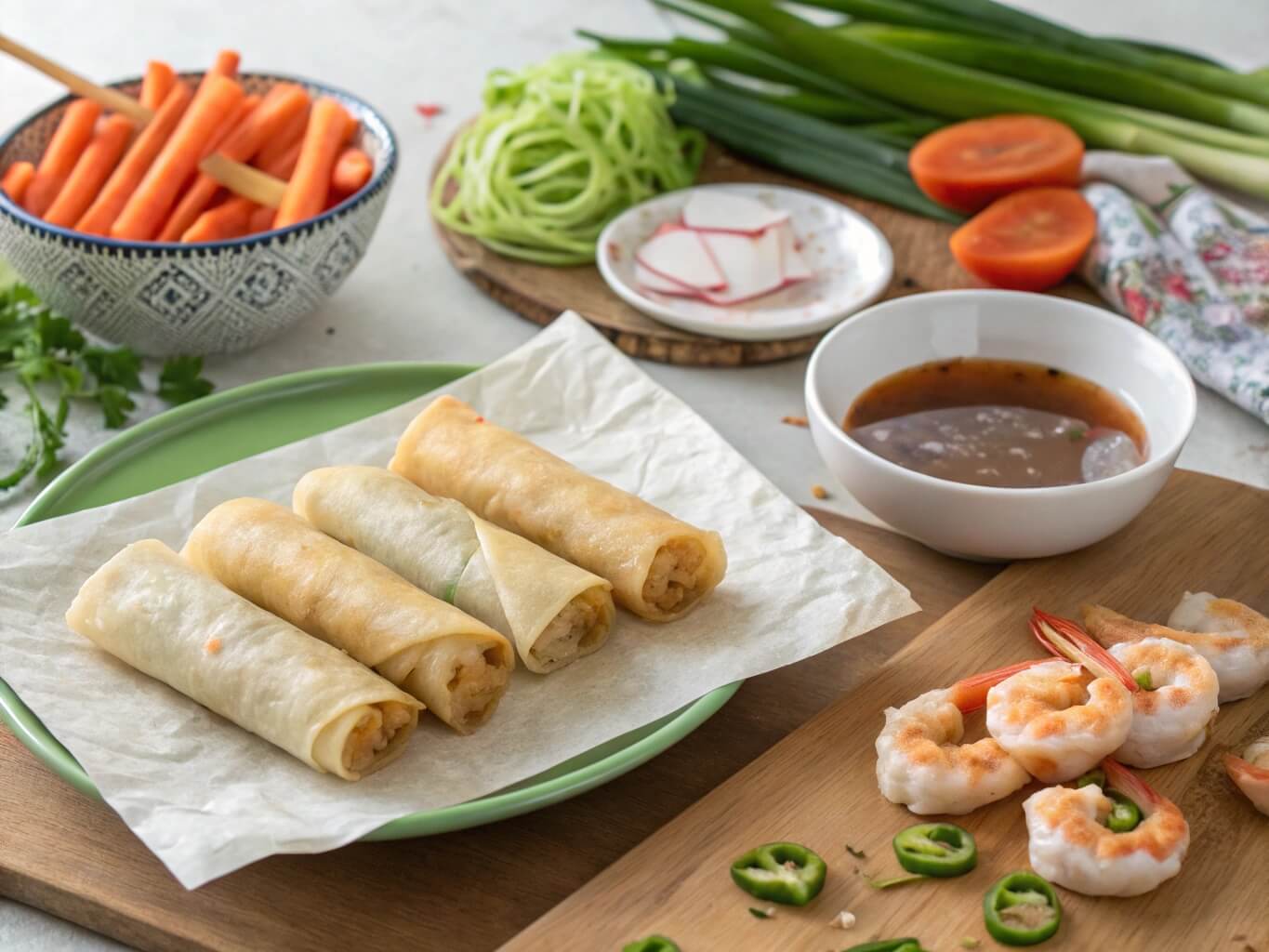Introduction
A spring roll recipe involves creating a crispy and flavorful dish that varies by region and culture, offering a delicious balance of textures and tastes. From the crispy fried rolls in Chinese cuisine to the fresh Vietnamese versions, the key to success lies in selecting the best ingredients. Wrappers, protein choices, and vegetables should be fresh, vibrant, and carefully selected, while seasonings like soy sauce, garlic, and sesame oil enhance the overall flavor. Cooking methods like frying, baking, or air-frying each bring a unique texture to the spring rolls. Experimenting with different fillings, dipping sauces, fresh herbs, and seasonings lets you personalize the recipe for any occasion or dietary preference, making them versatile and crowd-pleasing.
What Are Spring Rolls?
A perfect spring roll recipe starts with high-quality ingredients for the best flavor and texture. Here’s what you need:
- Wrappers: Choose between rice paper for fresh rolls or wheat-based wrappers for crispy fried rolls.
- Protein: Options include shrimp, pork, chicken, or tofu for variety.
- Vegetables: Use carrots, cabbage, mushrooms, and bean sprouts for crunch and freshness.
- Seasonings: Enhance flavor with soy sauce, garlic, ginger, and sesame oil.
- Freshness Matters: Always select fresh ingredients to achieve vibrant flavors and the perfect bite.
With the right combination, your spring rolls will be flavorful, crispy, and satisfying. For a related recipe, you can check out this Vegetable Spring Roll Recipe.
Origin and History
The origins of the spring roll recipe date back to ancient China, where they were initially prepared as a seasonal dish to celebrate the arrival of spring. Over time, this delicacy spread across Asia, with each region developing unique variations. Vietnamese spring rolls are often wrapped in rice paper and served fresh, while Thai and Filipino versions are deep-fried for a golden, crispy finish
.
As spring rolls gained popularity worldwide, chefs experimented with different fillings, sauces, and preparation techniques. Today, they are a beloved part of street food culture and restaurant menus across the globe.
Essential Ingredients
A delicious spring roll recipe depends on the perfect balance of ingredients. Here’s what you’ll need:
- Wrappers: Choose rice paper for fresh rolls or wheat-based wrappers for a crispy texture.
- Protein: Options like shrimp, pork, chicken, or tofu add heartiness.
- Vegetables: Use carrots, cabbage, mushrooms, and bean sprouts for crunch and freshness.
- Seasonings: Enhance flavor with soy sauce, garlic, ginger, and sesame oil.
- Freshness Matters: High-quality, fresh ingredients ensure the best texture and taste.

By carefully selecting each element, your spring rolls will turn out flavorful, crisp, and satisfying.
Alternative Fillings and Wrappers
If you want to modify your spring roll recipe, try these alternatives:
Wrap options: Lettuce, egg roll wrappers, or rice paper.
Protein choices: Crab, beef, tempeh, or scrambled eggs.
Vegetable add-ins: Bell peppers, zucchini, spinach, or sweet potatoes.
These variations allow you to personalize your spring rolls, catering to different dietary needs, preferences, and flavors. Whether you’re seeking a lighter version with lettuce or a heartier option with beef or tempeh, the possibilities are endless! Feel free to get creative and experiment with combinations that suit your taste and nutritional goals.
For a simple option, consider this Easy Spring Roll Recipe.
Vegan and Gluten-Free Options
Creating a vegan and gluten-free spring roll recipe is simple with the right ingredients:
Use rice paper wrappers instead of wheat-based ones.
Substitute soy sauce with tamari or coconut aminos.
Choose plant-based fillings like mushrooms, tofu, or jackfruit.
These adjustments ensure your spring rolls meet various dietary needs while maintaining great taste and texture. Whether you’re following a vegan or gluten-free diet, these swaps allow you to enjoy delicious, healthy spring rolls without compromising on flavor. Feel free to experiment with different fillings to make them truly your own!
Preparing the Filling
The filling is the heart of any spring roll recipe. Follow these steps for a flavorful, well-balanced filling:
- Heat oil in a pan and sauté garlic and ginger until fragrant.
- Add protein and cook thoroughly.
- Toss in vegetables and stir-fry briefly to retain their crunch.
- Season with soy sauce and sesame oil for depth of flavor.
- Allow the filling to cool before wrapping.

A well-prepared filling ensures evenly flavored spring rolls.
Wrapping Techniques
Proper wrapping prevents spring rolls from falling apart during cooking. Follow these tips:
Tightly wrapped spring rolls retain their shape and cook evenly, ensuring a crispy texture and delicious result.
Place the wrapper on a flat surface.
Add a spoonful of filling near the center.
Fold the sides inward, then roll tightly.
Seal the edges using a cornstarch slurry.
Frying vs. Baking vs. Air-Frying
Different cooking methods affect the texture of your spring roll recipe:
- Frying: Yields the crispiest results with golden-brown perfection.
- Baking: A healthier option that still offers some crunch.
- Air-frying: Uses less oil while achieving a crispy texture.
Each technique provides unique results, allowing you to choose based on preference, dietary needs, and desired crispiness..
Traditional Dipping Sauces
A delicious spring roll recipe is incomplete without the right dipping sauce. Popular options include:
- Hoisin sauce: Sweet and tangy, often paired with fresh rolls.
- Peanut sauce: A creamy, nutty complement to crispy rolls.
- Sweet chili sauce: A balance of heat and sweetness.
Each sauce enhances the taste of your spring rolls.
Unique Sauce Variations
For a creative twist, try these sauce ideas:
Mango-chili sauce: A fruity kick with a mild spice.
Coconut-lime sauce: Creamy with a refreshing citrus burst.
Soy-ginger dipping sauce: A salty and aromatic option.
These variations offer unique, flavorful options to complement your spring rolls. Whether you prefer a sweet and spicy mix or a creamy citrus dip, these sauces will elevate the taste of your dish and provide a fresh take on the classic. Experiment with these sauces to create a more exciting and personalized spring roll experience!
Avoiding Soggy Wrappers
To keep spring rolls crispy:
- Pat dry vegetables before filling.
- Avoid overstuffing.
- Drain fried rolls on a wire rack.
These steps help preserve the perfect crispy texture. By ensuring the fillings are dry, not overloaded, and properly drained, you’ll keep your spring rolls crisp on the outside while maintaining their delicious flavor inside. Simple but effective tips for achieving that satisfying crunch with every bite!
Preventing Filling Leakage
To prevent spills:
- Use properly sealed wrappers.
- Roll tightly without air pockets.
- Avoid excess liquid in the filling.
This ensures neatly wrapped spring rolls. By sealing the wrappers well, you create a secure enclosure that keeps everything in place. Rolling tightly eliminates gaps where ingredients could shift or spill. Additionally, making sure the filling isn’t too wet prevents the wrappers from becoming soggy and prone to tearing. These simple steps will help you create well-formed spring rolls that are easy to handle and less likely to fall apart.
Best Ways to Serve
Serve spring rolls with:
- Fresh herbs for garnish.
- A side of dipping sauce.
- A crisp salad for balance.
Presentation enhances the overall experience. By adding fresh herbs like cilantro or mint, you elevate the flavor and appearance. Pairing your spring rolls with a flavorful dipping sauce brings an extra layer of taste, while a crisp salad offers a refreshing contrast. These additions not only make your dish more visually appealing but also provide a well-rounded meal that’s both satisfying and delicious.
Storing and Reheating Tips
To store spring rolls:
- Refrigerate in an airtight container.
- Reheat in an oven or air fryer for crispiness.
- Avoid microwaving to prevent sogginess.

Proper storage preserves both texture and flavor. Keeping the spring rolls in an airtight container helps maintain freshness, while reheating them in an oven or air fryer restores their crispy exterior. Microwaving can make them soggy, so it’s best to avoid it. With these simple steps, you can enjoy your spring rolls later without losing the delicious crunch and taste.
FAQs:
Vegetable Spring Rolls Recipe
A vegetable spring rolls recipe is a delicious and healthy appetizer made with fresh, crunchy vegetables wrapped in a thin wrapper. The filling typically includes shredded carrots, cabbage, bean sprouts, and bell peppers, seasoned with garlic, ginger, and soy sauce. To prepare, sauté the vegetables lightly to retain their crispness, then wrap them tightly in spring roll wrappers. Fry until golden brown or bake for a lighter option. Serve with sweet chili or peanut sauce for added flavor. This vegetable spring rolls recipe is perfect for vegetarians and can be customized with additional ingredients like tofu or mushrooms.
Chicken Spring Roll Recipe
A chicken spring roll recipe combines tender, seasoned chicken with crisp vegetables for a flavorful bite. Start by stir-frying diced or shredded chicken with garlic, ginger, and soy sauce. Add carrots, cabbage, and onions, cooking briefly to maintain texture. Place the mixture on a spring roll wrapper, roll tightly, and seal the edges with water or egg wash. Fry until golden and crispy, or bake for a healthier option. Serve with hoisin, peanut, or sweet chili sauce. This chicken spring roll recipe is great for appetizers, snacks, or party platters, offering a perfect balance of crunch and flavor.
Vietnamese Spring Roll Recipe
A Vietnamese spring roll recipe features fresh ingredients wrapped in delicate rice paper, offering a light and healthy option. Fillings typically include shrimp, vermicelli noodles, lettuce, herbs like mint and cilantro, and julienned vegetables. To assemble, soak rice paper briefly in warm water, layer the ingredients, and roll tightly. Serve with a peanut or nuoc cham dipping sauce for authentic flavor. Unlike fried rolls, these fresh rolls are soft, chewy, and packed with freshness. This Vietnamese spring roll recipe is ideal for summer meals, appetizers, or a nutritious snack, showcasing the vibrant flavors of Vietnamese cuisine.
Chinese Spring Roll Recipe
A Chinese spring roll recipe consists of crispy, golden-brown rolls filled with savory ingredients. The filling often includes shredded cabbage, carrots, bamboo shoots, and a choice of pork, chicken, or shrimp. Season with soy sauce, oyster sauce, and a dash of white pepper for depth of flavor. Wrap the filling in a thin wheat-based wrapper, roll tightly, and deep-fry until crispy. Serve with a side of sweet and sour sauce for an authentic touch. This Chinese spring roll recipe is a popular dish during Lunar New Year celebrations and is enjoyed as a crunchy, flavorful appetizer or snack.
Easy Spring Roll Recipe
For a quick and delicious treat, an easy spring roll recipe requires minimal ingredients and effort. Use pre-shredded vegetables like carrots, cabbage, and bean sprouts, along with cooked shrimp, chicken, or tofu. Lay the filling on a spring roll wrapper, roll it securely, and seal with a bit of water. Fry until crispy or air-fry for a healthier alternative. Serve with sweet chili or soy-ginger dipping sauce. This easy spring roll recipe is perfect for busy weeknights or last-minute appetizers, providing a simple yet satisfying dish that anyone can master at home with minimal preparation.
Spring Roll Wrappers
Spring roll wrappers are thin sheets made from wheat or rice flour, used to encase flavorful fillings. Wheat-based wrappers are commonly used for fried spring rolls, offering a crispy texture when cooked. Rice paper wrappers, on the other hand, are popular for fresh Vietnamese spring rolls, providing a soft, chewy bite. To use, wheat wrappers should be lightly moistened before rolling, while rice paper requires a brief soak in warm water. Proper storage is essential—keep them sealed to prevent drying out. Choosing the right spring roll wrappers ensures the perfect texture and appearance for your homemade rolls.
Conclusion
Making spring rolls at home is an enjoyable and rewarding experience. With the right techniques and ingredients, you can achieve restaurant-quality results in your own kitchen. Whether you prefer traditional fried rolls or a healthier baked version, mastering the wrapping and cooking process ensures a crispy, flavorful bite every time. Plus, experimenting with different fillings and sauces allows you to customize them to your taste. Spring rolls are perfect for parties, appetizers, or even a light meal, making them a versatile addition to any menu. By following this guide, you’ll gain confidence in crafting the perfect spring rolls, impressing family and friends with your culinary skills. Enjoy the process, and happy cooking!

